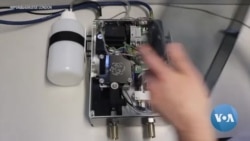A hospital team in Britain has come up with what it says is a low cost, high performance ventilator to aid patients with the coronavirus, adding that the system could be quickly rolled out in developing countries with poor health systems. The global demand for medical ventilators has soared as COVID-19 spreads around the world.
Doctors and engineers at Imperial College London went back to basics and came up with JamVent, a ventilator that can be built cheaply anywhere in the world, says project lead Dr. Joseph Sherwood.
“By knowing the way that a gas behaves under pressure and how the flow of a gas occurs through a valve, you can actually choose the components of a system such that you can control the pressures and flows exactly as you need to without the need for these complex components,” Sherwood told VOA in a recent interview.
Those complex parts can cost tens of thousands of dollars. JamVent uses readily available “off-the-shelf" components, explains co-designer Dr. Jakob Mathiszig-Lee, who works on the front line treating COVID-19 patients at London’s Royal Brompton Hospital. “We’re not competing with existing ventilator designs or parts. And also because it’s so simple, actually it’s very scalable to build and very easy for someone to source these parts anywhere in the world, really.“
That includes developing countries with poor health systems. Some African countries have only a handful of ventilators to treat millions of people.
The designers plan to test assembly line prototypes in May and seek approval for clinical use in Britain and the United States. Unlike other recent designs, the JamVent is designed to meet the full demands of intensive care, with the “Pressure Regulated Volume Controlled” mode preferred by most doctors, the ability to maintain pressure during suction, and a mode to help wean patients off mechanical ventilation, known as the “spontaneous breathing mode.”
“This is not a ‘bridge’ ventilator,” said Mathiszig-Lee, referring to the less complex designs that have more limited capabilities and typically are not designed for intensive care. “This is a ventilator that does all of the functions that you need in the ICU to cope with COVID-19 patients and their demanding requirements. The design is actually freely available, and we would work with different manufacturers to go through their own regulatory procedures.”
The full design is freely available on the JamVent website and anyone interested in working with the Imperial College team is encouraged to get in touch.
Doctor Mathiszig-Lee says its potential goes beyond the COVID-19 pandemic.
“There’s no reason that this can’t be used to supplement ICU [intensive care unit] capability around the world going forward for any kind of respiratory condition.”









